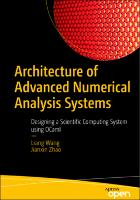Architecture of Advanced Numerical Analysis Systems
Designing a Scientific Computing System using OCaml
| dc.contributor.author | Wang, Liang | |
| dc.contributor.author | Zhao, Jianxin | |
| dc.date.accessioned | 2023-01-20T16:54:27Z | |
| dc.date.available | 2023-01-20T16:54:27Z | |
| dc.date.issued | 2023 | |
| dc.identifier | ONIX_20230120_9781484288535_37 | |
| dc.identifier.uri | https://library.oapen.org/handle/20.500.12657/60830 | |
| dc.description.abstract | This unique open access book applies the functional OCaml programming language to numerical or computational weighted data science, engineering, and scientific applications. This book is based on the authors' first-hand experience building and maintaining Owl, an OCaml-based numerical computing library. You'll first learn the various components in a modern numerical computation library. Then, you will learn how these components are designed and built up and how to optimize their performance. After reading and using this book, you'll have the knowledge required to design and build real-world complex systems that effectively leverage the advantages of the OCaml functional programming language. What You Will Learn Optimize core operations based on N-dimensional arrays Design and implement an industry-level algorithmic differentiation module Implement mathematical optimization, regression, and deep neural network functionalities based on algorithmic differentiation Design and optimize a computation graph module, and understand the benefits it brings to the numerical computing library Accommodate the growing number of hardware accelerators (e.g. GPU, TPU) and execution backends (e.g. web browser, unikernel) of numerical computation Use the Zoo system for efficient scripting, code sharing, service deployment, and composition Design and implement a distributed computing engine to work with a numerical computing library, providing convenient APIs and high performance Who This Book Is For Those with prior programming experience, especially with the OCaml programming language, or with scientific computing experience who may be new to OCaml. Most importantly, it is for those who are eager to understand not only how to use something, but also how it is built up. | |
| dc.language | English | |
| dc.subject.classification | thema EDItEUR::U Computing and Information Technology | en_US |
| dc.subject.classification | thema EDItEUR::U Computing and Information Technology::UY Computer science | en_US |
| dc.subject.classification | thema EDItEUR::U Computing and Information Technology::UM Computer programming / software engineering::UMB Algorithms and data structures | en_US |
| dc.subject.classification | thema EDItEUR::U Computing and Information Technology::UY Computer science::UYQ Artificial intelligence | en_US |
| dc.subject.other | programming language | |
| dc.subject.other | OCaml | |
| dc.subject.other | scientific computing | |
| dc.subject.other | computational | |
| dc.subject.other | debugging | |
| dc.subject.other | open source | |
| dc.subject.other | source | |
| dc.subject.other | code | |
| dc.subject.other | numerical | |
| dc.subject.other | data science | |
| dc.subject.other | big data | |
| dc.subject.other | owl | |
| dc.subject.other | functional | |
| dc.subject.other | math | |
| dc.subject.other | scientific | |
| dc.subject.other | engineering | |
| dc.title | Architecture of Advanced Numerical Analysis Systems | |
| dc.title.alternative | Designing a Scientific Computing System using OCaml | |
| dc.type | book | |
| oapen.identifier.doi | 10.1007/978-1-4842-8853-5 | |
| oapen.relation.isPublishedBy | 6c6992af-b843-4f46-859c-f6e9998e40d5 | |
| oapen.relation.isFundedBy | 540a0270-1d16-4d8b-a318-33daed78f1e1 | |
| oapen.relation.isbn | 9781484288535 | |
| oapen.imprint | Apress | |
| oapen.pages | 472 | |
| oapen.place.publication | Berkeley, CA | |
| oapen.grant.number | [...] |

